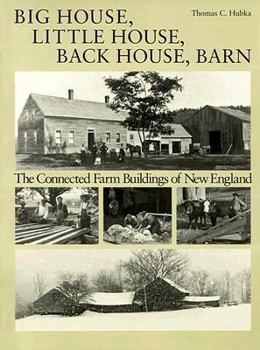Big House, Little House, Back House, Barn
Select Format
Select Condition 
Book Overview
A classic work on farm buildings made by nineteenth-century New Englanders refreshed with a new introduction. Big House, Little House, Back House, Barn portrays the four essential components of the... This description may be from another edition of this product.
Format:Paperback
Language:English
ISBN:0874513561
ISBN13:9780874513561
Release Date:January 1984
Publisher:University Press of New England
Length:240 Pages
Weight:1.70 lbs.
Dimensions:0.6" x 8.7" x 11.6"
Customer Reviews
5 ratings
New England Farm Architecture
Published by Thriftbooks.com User , 18 years ago
The author gives the "how and why the connected farm emerged in the mid-to-late 19th century and the story these buildings tell about the common New England farm and the people who made them." Hubka has written extensively about traditional American buildings and architectural design methods and teaches at the School of Architecture and Urban Planning at the University of Wisconsin, Madison. I love the old pictures like the one showing a family and horses in front of a Saco house and barn. "According to Hubka, the primary reason for connected farms was agrarian reform, which was spurred in the 1840s and '50s by competition from new, larger farms in the Midwest. Connected buildings allowed New Englanders to take on home-based industry, such as candle- and cheese-making, while continuing to farm and still have everything centralized. Fashion also played a part: Connected farms became the latest thing, and keeping up with the neighbors was important even then." (This Old House) "An important pioneering effort. The book commemorates both an unique indigenous architectural expression and a way of life that has become extinct . . . The style is economic and clear and Hubka's affection for architecture binds the buildings to their people and their times." -- Maine Sunday Times
Big house, Little House, Back House Barn
Published by Thriftbooks.com User , 18 years ago
Very imformative. The images of the older New England homes are very interesting and useful.
Enthralling rural history.
Published by Thriftbooks.com User , 20 years ago
Lets get this straight, this is NOT a coffee table book - if you want lots of colour pictures of old farms and barns - look elsewhere. What it is though, is a well written, brilliantly researched and documented assessment of a largely by-gone way of life in rural New England. Look - I'm even British and I loved (OK - I do have an interest in New England and architecture) If you are vaguely interested in old rural life, agriculture, history and social history, or vernacular architecture (or any combination of these) - buy it you won't be disappointed.
Powerful debunker of Maine myth!
Published by Thriftbooks.com User , 23 years ago
If you have ever wandered around Maine, you will have noticed a unique form of farm architecture. But ask most people why 19th century Maine farmers made such a concerted effort to physically connect the structures on their farms and the answer is "they needed a way to get to the barn through the winter snow." Trust me, I have gone around and asked current dwellers of Maine farmsteads. Thomas Hubka carefully points out that if that were so, we'd see similar connected farm architecture in parts of the nation where winters were even more inclimate and snowier. Yet Maine farm architecture remains almost totally enigmatic. Hubka's diligent field work reveals that forces were at work in mid-19th century Maine that conspired against the rural farmer: industrial competition for hand-manufactured goods produced at home for cash suppliment, a labor drain to other more prosperous farming regions, and unyielding land. The brilliance of Hubka's work is that he evokes how, despite all this, Maine farmers strove to adapt by creating resilliant islands of industry with the structure of their homes that defiantly sheltered year-round dooryard work efforts from wind and snow, but also change abroad. This book is also a perfect source of pithy detail and illustration regarding 17th century cape-style house architecture which, it turns out, is still ubiquitous in New England. Highly recommended, a stiking work.
when lilacs last in the dooryard bloomed
Published by Thriftbooks.com User , 23 years ago
There's a type of farm layout that you see in New England that you don't see elsewhere in the US. This book is a study of that type of farm, its whys and wherefores, and how it fit into people's lives -- or better, how their lives fit into it. This book is written very clearly, with numerous graceful diagrams of floor plans, layouts, and photos of representative farms. The author has a deep sympathy for the ordinary farmers and their taxing occupation, as can be seen in the choice of photos (farmhouse buried in snow, barn on fire, farm family sitting in a front yard still dominated by those granite cobbles you expect to be piled into fences). Diagrams tell the demographic story of why these farms were created, why they belong to northern New England; how they were achieved and how people spent their lives in them. For me, the magic comes in because I fell in love with one of these farms, and its sunny Lincoln-era dooryard. It has a subtle rightness because of its orientation, its site on a knoll, and a certain flexibility of layout. But even if you don't have such a reference point, I think you will be impressed at the perceptiveness of the work, if you can muster any interest at all in the topic. p.s. I checked on the Web to see if the author is still flourishing. His current project seems to be the wooden synogogues of tiny eastern european towns. Sounds neat...





